Reduction of Heat Losses in a Pre-Insulated Network Located in Central Poland by Lowering the Operating Temperature of the Water and the Use of Egg-shaped Thermal Insulation: A Case Study
Abstract
:1. Introduction
2. Optimization of the Shape of the Thermal Insulation for the Pre-Insulated Double Duct Based on the Temperature Field and the Heat Flux Density Distribution in the Cross-Section of the Thermal Insulation
3. Ecological Effect of Modifying Operating Parameters and the Shape of Thermal Insulation of an Existing Pre-Insulated Heating Network Located in Central Poland
- -
- Variant A in which the operating temperature of the network was reduced from TS/TR = 130/55 °C to 70/25 °C during the whole year without changes in the geometry of the heating network;
- -
- Variant B consisting of the replacement of single pipes with double pre-insulated pipes with standard round thermal insulation, maintaining the parameters of 130/55 °C heating network operation in the heating season and 70/25 °C after the heating season;
- -
- Variant C consisting of the replacement of single pre-insulated pipes with double pre-insulated pipes with standard circular thermal insulation with a temperature reduction as in variant A;
- -
- Variant D consisting of using egg-shaped thermal insulation pipes with maintenance of 130/55 °C network operation parameters during the heating season and 70/25 °C after the heating season;
- -
- Variant E consisting of the use of egg-shaped thermal insulation pipes with a temperature reduction as in variant A.
4. Conclusions
Author Contributions
Funding
Acknowledgments
Conflicts of Interest
References
- Guelpa, E.; Mutani, G.; Todeschi, V.V. Reduction of CO2 emissions in urban areas through optimal expansion of existing district heating networks. J. Clean. Prod. 2018, 204, 117–129. [Google Scholar] [CrossRef]
- Ravina, M.; Panepinto, D.; Zanetti, M.C.; Genon, G. Environmental analysis of a potential district heating network powered by a large-scale cogeneration plant. Environ. Sci. Pollut. Res. 2017, 24, 13424–13436. [Google Scholar] [CrossRef] [PubMed]
- Neirotti, F.; Noussan, M.; Riverso, S.; Manganini, G. Analysis of different strategies for lowering the operation temperature in existing district heating networks. Energies 2019, 12, 321. [Google Scholar] [CrossRef]
- Boysen, C.; Kaldemeyer, C.; Hilpert, S.; Tuschy, I. Integration of flow temperatures in unit commitment models of future district heating systems. Energies 2019, 12, 1061. [Google Scholar] [CrossRef]
- Millar, M.-A.; Burnside, N.M.; Yu, Z. District heating challenges for the UK. Energies 2019, 12, 310. [Google Scholar] [CrossRef]
- Lund, H.; Werner, S.; Wiltshire, R.; Svendsen, S.; Thorsen, J.E.; Hvelplund, F.; Vad Mathiesen, B. 4th generation district heating (4GDH) integrating smart thermal grids into future sustainable energy systems. Energy 2014, 68, 1–11. [Google Scholar] [CrossRef]
- Kontu, K.; Vimpari, J.; Penttinen, P.; Junnila, S. City scale demand side management in three different-sized district heating systems. Energies 2018, 11, 3370. [Google Scholar] [CrossRef]
- Maljkovic, D. Modelling influential factors of consumption in buildings connected to district heating systems. Energies 2019, 12, 586. [Google Scholar] [CrossRef]
- Pirouti, M.; Bagdanavicius, A.; Ekanayake, J.; Wu, J.; Jenkins, N. Energy consumption and economic analyses of a district heating network. Energy 2013, 57, 149–159. [Google Scholar] [CrossRef]
- Krawczyk, D.A.; Teleszewski, T.J. Optimization of geometric parameters of thermal insulation of pre-insulated double pipes. Energies 2019, 12, 1012. [Google Scholar] [CrossRef]
- Van der Heijde, B.; Aertgeerts, A.; Helsen, L. Modelling steady-state thermal behavior of double thermal network pipes. Int. J. Therm. Sci. 2017, 117, 316–327. [Google Scholar] [CrossRef]
- Khosravi, M.; Arabkoohsar, A. Thermal-hydraulic performance analysis of twin-pipes for various future district heating schemes. Energies 2019, 12, 1299. [Google Scholar] [CrossRef]
- Dalla Rosa, A.; Li, H.; Svendsen, S. Method for optimal design of pipes for low-energy district heating with focus on heat losses. Energy 2011, 36, 2407–2418. [Google Scholar] [CrossRef]
- Krawczyk, D.A.; Teleszewski, T.J. Effects of some geometric parameters in energy-efficient heat distribution of pre-insulated double pipes. Proceedings 2018, 2, 1520. [Google Scholar] [CrossRef]
- Teleszewski, T.J.; Zukowski, M. Modification of the shape of thermal insulation of a twin-pipe pre-insulated network. AIP Conf. Proc. 2019, 2078, 020030. [Google Scholar]
- Bøhm, B.; Kristjansson, H. Single, twin and triple buried heating pipes: On potential savings in heat losses and costs. Int. J. Energy Res. 2005, 29, 1301–1312. [Google Scholar] [CrossRef]
- Kudela, L.; Chylek, R.; Pospisil, J. Performant and simple numerical modeling of district heating pipes with heat accumulation. Energies 2019, 12, 633. [Google Scholar] [CrossRef]
- Song, S.H.; Cheing, T. Pattern-based set partitioning algorithm for the integrated sustainable operation of a district heating network. Sustainability 2018, 10, 2774. [Google Scholar] [CrossRef]
- Yang, W.; Wen, F.; Wang, K.; Huang, Y.; Salam, M.A. Modeling of a district heating system and optimal heat-power flow. Energies 2018, 11, 929. [Google Scholar] [CrossRef]
- Sun, G.; Wang, W.; Wu, Y.; Hu, W.; Yang, Z.; Wei, Z.; Zang, H.; Chen, S. A nonlinear analytical algorithm for predicting the probabilistic mass flow of a radial district heating network. Energies 2019, 12, 1215. [Google Scholar] [CrossRef]
- Zhao, J.; Shan, Y. An influencing parameters analysis of district heating network time delays based on the CFD method. Energies 2019, 12, 1297. [Google Scholar] [CrossRef]
- Danielewicz, J.; Śniechowska, B.; Sayegh, M.A.; Fidorów, N.; Jouhara, H. Three-dimensional numerical model of heat losses from district heating network pre-insulated pipes buried in the ground. Energy 2016, 108, 172–184. [Google Scholar] [CrossRef] [Green Version]
- Teleszewski, T.J.; Sorko, S.A. Effect of viscous dissipation on forced convection for laminar flow through a straight regular polygonal duct using BEM method. Int. J. Numer. Methods Heat Fluid Flow 2018, 28, 220–238. [Google Scholar] [CrossRef]
- Brebbia, C.A.; Telles, J.C.F.; Wrobel, L.C. Boundary Element Techniques—Theory and Applications in Engineering; Springer: Berlin/Heidelberg, Germany; New York, NY, USA; Tokyo, Japan, 1984; Chapter 2. [Google Scholar]
- British Standards Institution. BS EN 253 District Heating Pipes. Preinsulated Bonded Pipe Systems for Directly Buried Hot Water Networks. Pipe Assembly of Steel Service Pipe, Polyurethane Thermal Insulation and Outer Casing of Polyethylene; British Standards Institution: Brussels, Belgium, 2009. [Google Scholar]
- Google Maps. Available online: https://www.google.pl/maps (accessed on 1 April 2019).
- Krawczyk, D.A. Design of a district heating network from a boiler room to buildings. 2007. [Google Scholar]
- Smyk, A.; Pietrzyk, Z. Selection of the optimal pipeline diameter for district heating network. Rynek Energii 2011, 6, 98–105. (In Polish) [Google Scholar]
- Krawczyk, D.A. Theoretical and real effect of the school’s thermal modernization—A case study. Energy Build. 2014, 81, 30–37. [Google Scholar] [CrossRef]
- Cholewa, T.; Siuta-Olcha, A. Long term experimental evaluation of the influence of cost allocators on the energy consumption in the multifamily buildings. Energy Build. 2016, 104, 122–130. [Google Scholar] [CrossRef]
- European Environment Agency. EMEP/EEA Air Pollutant Emission Inventory Guidebook; European Environment Agency, Publications Office of the European Union: Luxemburg, 2016. [Google Scholar]
- Gómez, D.R.; Watterson, J.D.; Americano, B.B.; Ha, C.; Marland, G.; Matsika, E.; Namayanga, L.N.; Osman-Elasha, B.; Kalenga Saka, J.D.; Treanton, K.; et al. Intergovernmental Panel on Climate Change (IPCC) Guidelines for National Greenhouse Gas Inventories. Volume 2: Energy, Stationary Combustion. Institute for Global Environmental Strategies; IPCC: Hayama, Kanagawa, Japan, 2006; Chapter 2. [Google Scholar]
- Salo, S.; Hast, A.; Jokisalo, J.; Kosonen, R.; Syri, S.; Hirvonen, J.; Martin, K. The impact of optimal demand response control and thermal energy storage on a district heating system. Energies 2019, 12, 1678. [Google Scholar] [CrossRef]
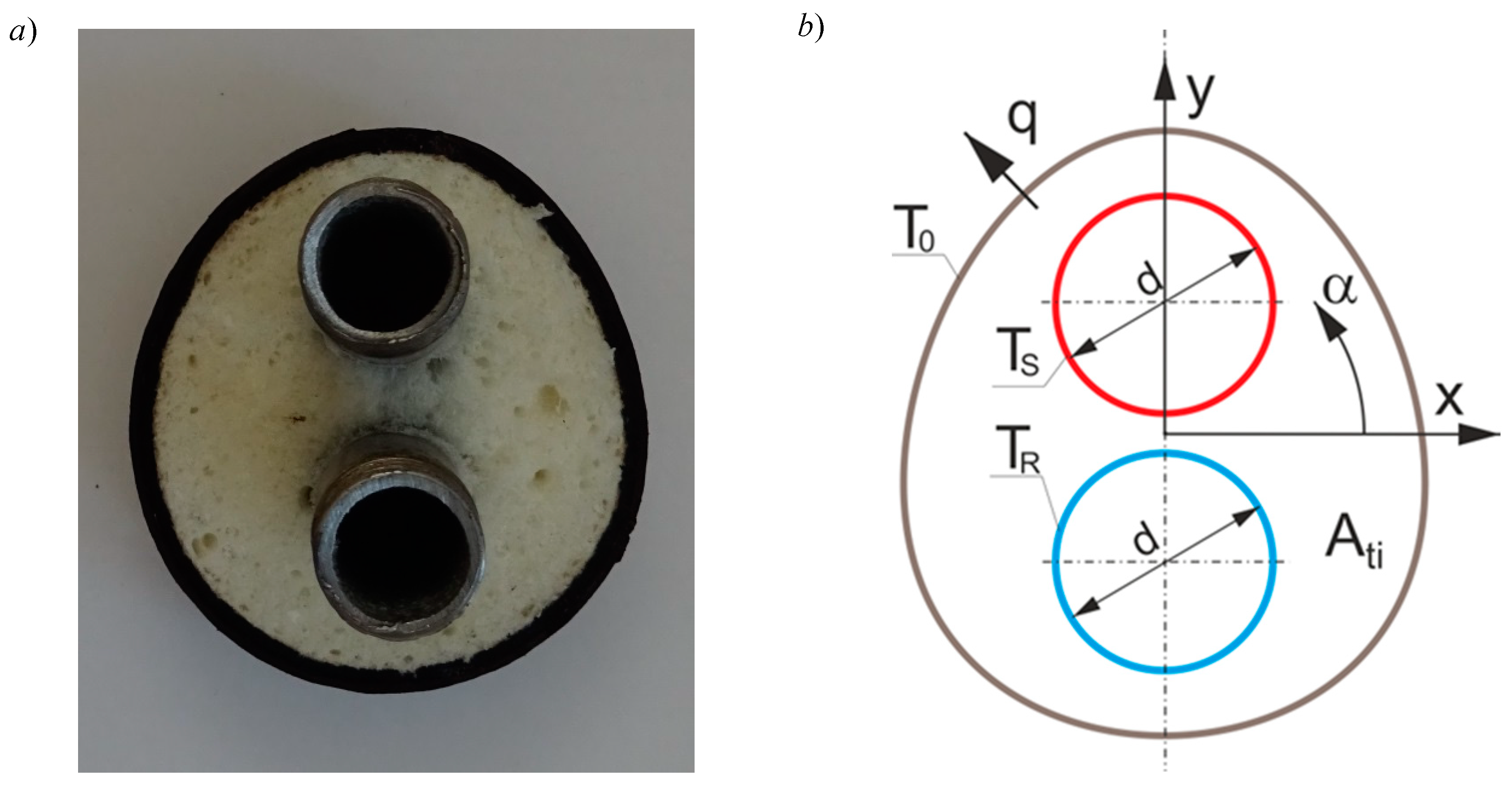
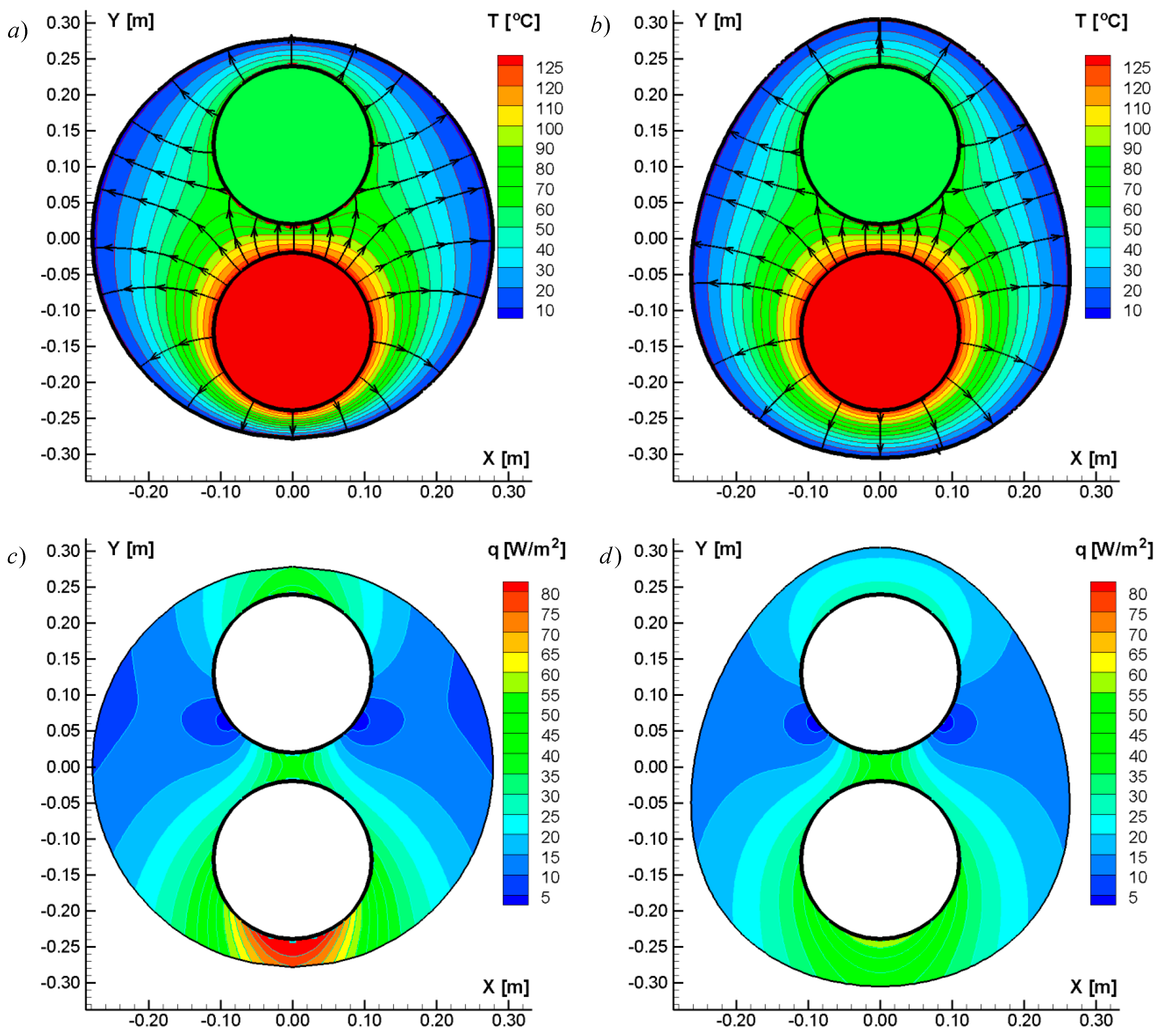
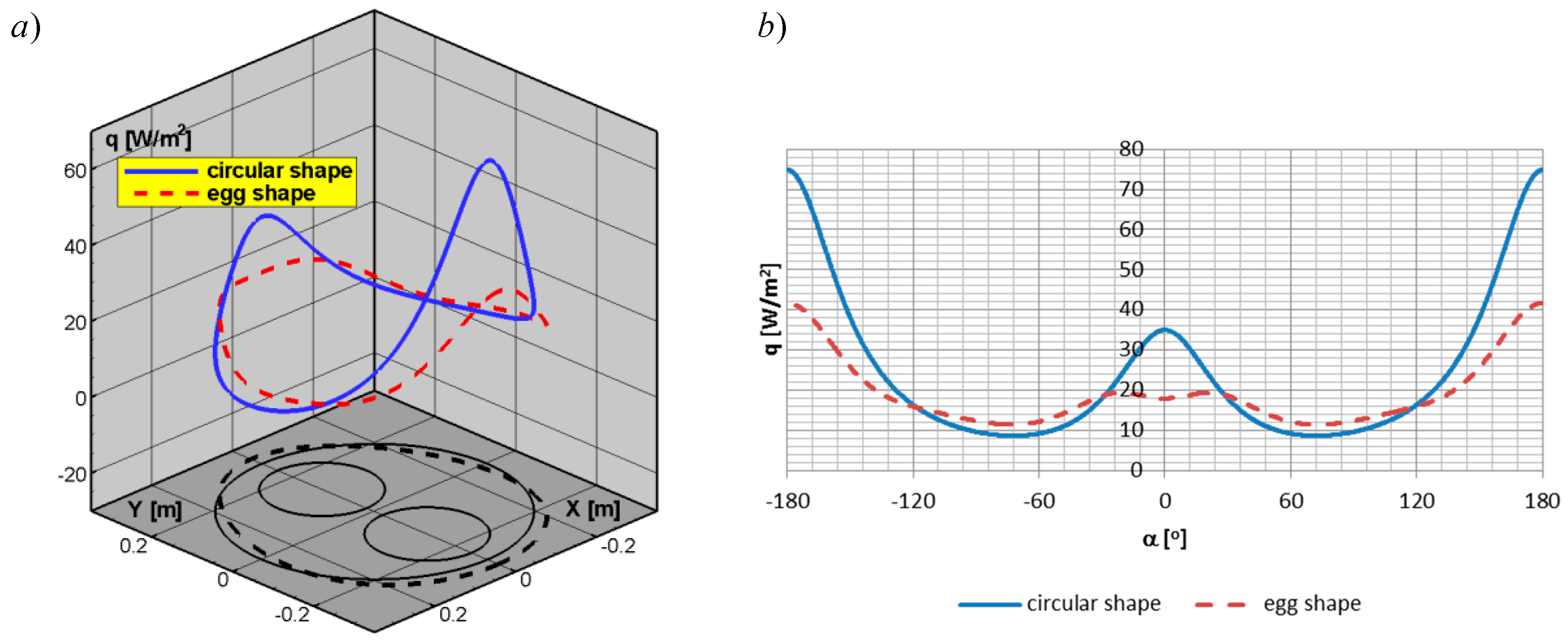
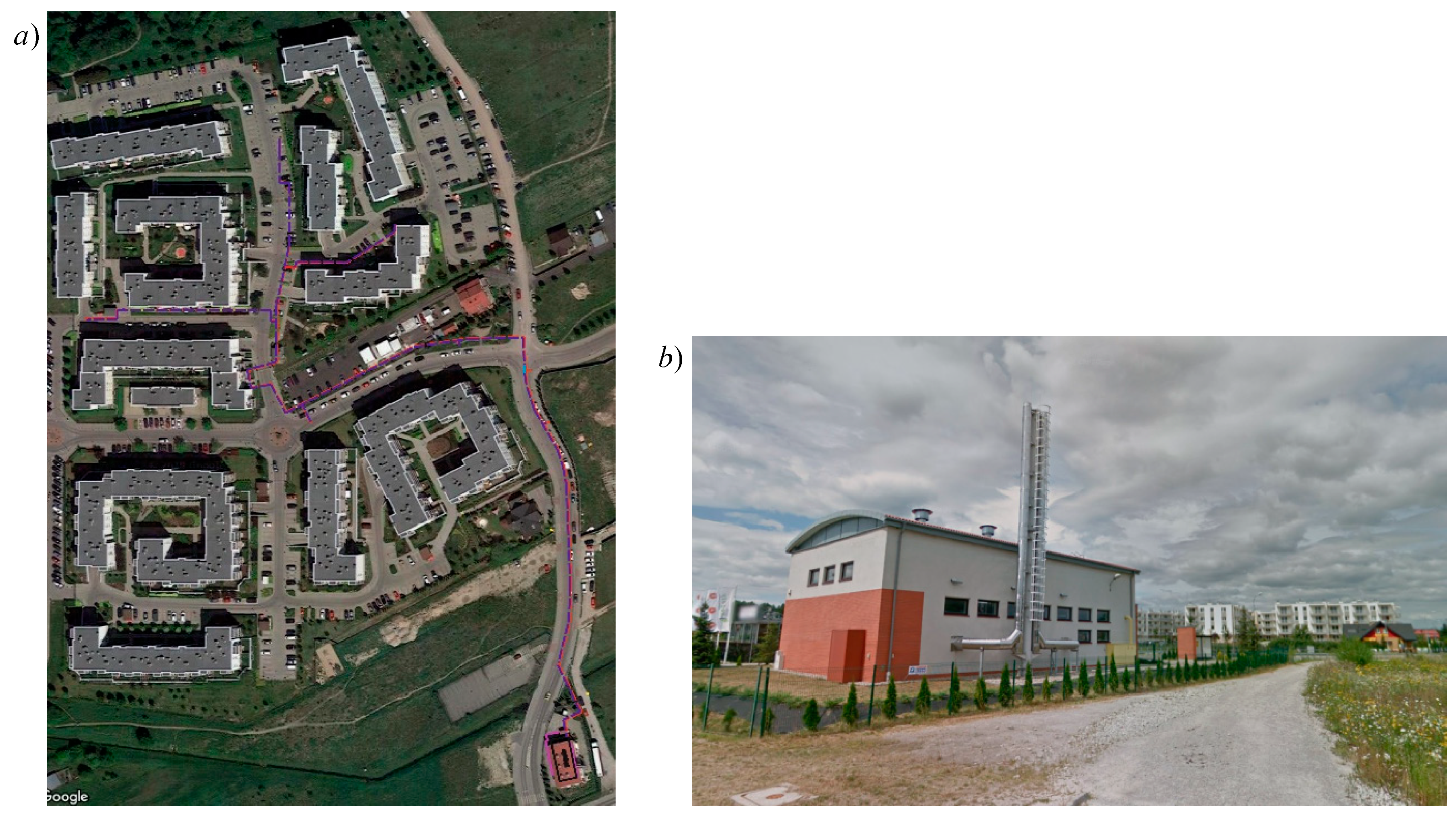
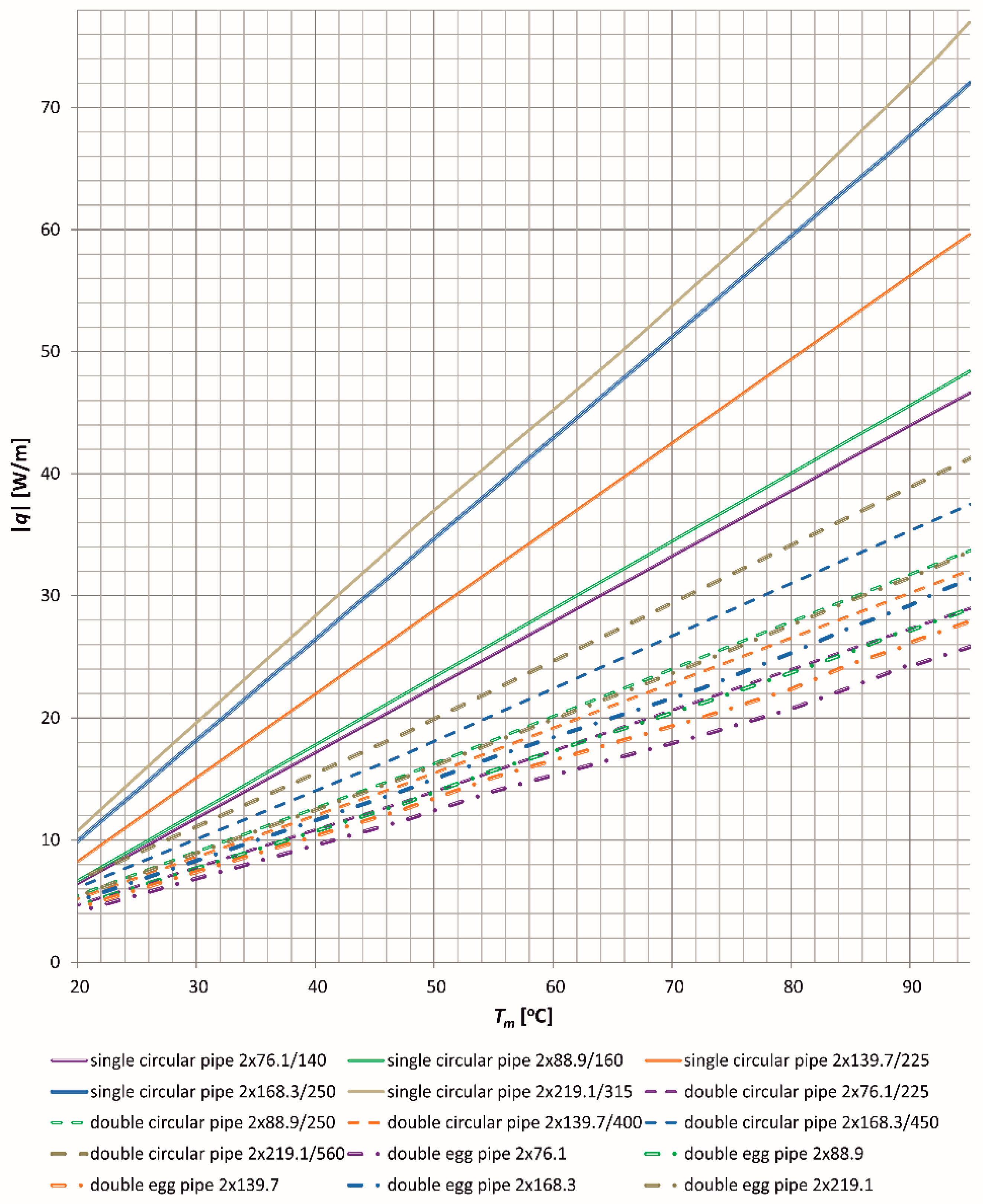
| D (mm) | d (mm) | L (m) | Ati (m2) (Supply + Return) | v (m/s) |
|---|---|---|---|---|
| 140 | 76.1 | 87.65 | 0.022 | 0.5 |
| 160 | 88.9 | 127.85 | 0.028 | 0.65 |
| 225 | 139.7 | 66.2 | 0.049 | 0.6 |
| 250 | 168.3 | 113 | 0.054 | 0.95 |
| 315 | 219.1 | 158.5 | 0.080 | 0.7 |
| D (mm) | d (mm) | Ati (m2) |
|---|---|---|
| 225 | 76.1 | 0.031 |
| 250 | 88.9 | 0.037 |
| 400 | 139.7 | 0.095 |
| 450 | 168.3 | 0.115 |
| 560 | 219.1 | 0.171 |
| Description of the Case and Introduced Changes | Energy for Heat Losses q (GJ/year) |
|---|---|
| Current state (ST), single pre-insulated network, 255 (day) (130/55 (°C)) + 110 (day) (70/25 (°C)) | 893.13 |
| Variant A, single pre-insulated network, 365 (day) (70/25 (°C)) | 497.36 |
| Variant B, double pre-insulated network with circular thermal insulation, 255 (day) (130/55 (°C)) + 110 (day) (70/25 (°C)) | 506.25 |
| Variant C, double pre-insulated network with circular thermal insulation, 365 (day) (70/25 (°C)) | 282.37 |
| Variant D, double pre-insulated network with egg thermal insulation, 255 (day) (130/55 (°C)) + 110 (day) (70/25 (°C)) | 427.19 |
| Variant E, double pre-insulated network with egg thermal insulation, 365 (day) (70/25 (°C)) | 236.45 |
| Pollutant | Ef (g/GJ) | EcsEf (kg/year) | EcaseBEf (kg/year) | EcaseDEf (kg/year) |
| 255 (day) (130/55 (°C)) + 110 (day) (70/25 (°C)) | ||||
| NOx | 89 | 79.49 | 45.06 | 38.02 |
| CO | 39 | 34.83 | 19.74 | 16.66 |
| NMVOC | 2.6 | 2.32 | 1.32 | 1.11 |
| SOx | 0.281 | 0.25 | 0.14 | 0.12 |
| TSP | 0.89 | 0.79 | 0.45 | 0.38 |
| PM10 | 0.89 | 0.79 | 0.45 | 0.38 |
| PM2.5 | 0.89 | 0.79 | 0.45 | 0.38 |
| CO2 | 56,100 | 50,104.72 | 28,400.43 | 23,965.16 |
| CH4 | 1 | 0.89 | 0.51 | 0.43 |
| Ef (g/GJ) | EcaseAEf (kg/year) | EcaseCEf (kg/year) | EcaseEEf (kg/year) | |
| 365 (day) (70/25 (°C)) | ||||
| NOx | 89 | 44.27 | 25.13 | 21.04 |
| CO | 39 | 19.40 | 11.01 | 9.22 |
| NMVOC | 2.6 | 1.29 | 0.73 | 0.61 |
| SOx | 0.281 | 0.14 | 0.08 | 0.07 |
| TSP | 0.89 | 0.44 | 0.25 | 0.21 |
| PM10 | 0.89 | 0.44 | 0.25 | 0.21 |
| PM2.5 | 0.89 | 0.44 | 0.25 | 0.21 |
| CO2 | 56,100 | 27,902.03 | 15,841.20 | 13,264.98 |
| CH4 | 1 | 0.50 | 0.28 | 0.24 |
| Pollutant | ΔEcs-caseA (kg/year) | ΔEcs-caseB (kg/year) | ΔEcs-caseC (kg/year) | ΔEcs-caseD (kg/year) | ΔEcs-caseE (kg/year) |
|---|---|---|---|---|---|
| NOx | 35.22 | 34.43 | 54.36 | 41.47 | 58.44 |
| CO | 15.44 | 15.09 | 23.82 | 18.17 | 25.61 |
| NMVOC | 1.03 | 1.01 | 1.59 | 1.21 | 1.71 |
| SOx | 0.11 | 0.11 | 0.17 | 0.13 | 0.18 |
| TSP | 0.35 | 0.34 | 0.54 | 0.41 | 0.58 |
| PM10 | 0.35 | 0.34 | 0.54 | 0.41 | 0.58 |
| PM2.5 | 0.35 | 0.34 | 0.54 | 0.41 | 0.58 |
| CO2 | 22,202.68 | 21,704.29 | 34,263.51 | 26,139.56 | 36,839.74 |
| CH4 | 0.40 | 0.39 | 0.61 | 0.47 | 0.66 |
© 2019 by the authors. Licensee MDPI, Basel, Switzerland. This article is an open access article distributed under the terms and conditions of the Creative Commons Attribution (CC BY) license (http://creativecommons.org/licenses/by/4.0/).
Share and Cite
Krawczyk, D.A.; Teleszewski, T.J. Reduction of Heat Losses in a Pre-Insulated Network Located in Central Poland by Lowering the Operating Temperature of the Water and the Use of Egg-shaped Thermal Insulation: A Case Study. Energies 2019, 12, 2104. https://doi.org/10.3390/en12112104
Krawczyk DA, Teleszewski TJ. Reduction of Heat Losses in a Pre-Insulated Network Located in Central Poland by Lowering the Operating Temperature of the Water and the Use of Egg-shaped Thermal Insulation: A Case Study. Energies. 2019; 12(11):2104. https://doi.org/10.3390/en12112104
Chicago/Turabian StyleKrawczyk, Dorota Anna, and Tomasz Janusz Teleszewski. 2019. "Reduction of Heat Losses in a Pre-Insulated Network Located in Central Poland by Lowering the Operating Temperature of the Water and the Use of Egg-shaped Thermal Insulation: A Case Study" Energies 12, no. 11: 2104. https://doi.org/10.3390/en12112104






